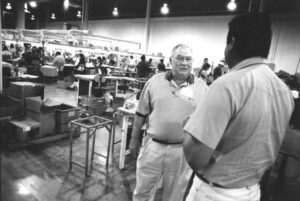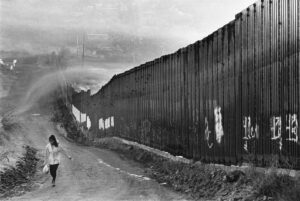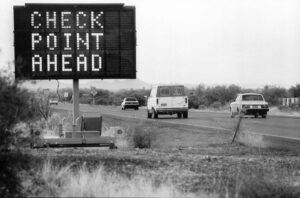Miriam Davidson
- 1997

Fellowship Title:
- Ambos Nogales: Border Town at the Breaking Point
Fellowship Year:
- 1997

Maquiladora Workers Get Homes of Their Own
Photographs by Jeffery Scott From his office window, Tom Higgins looks across the city of Nogales, Sonora, Mexico, and sees rows of new tin roofs shining on a hilltop. “I’m so pleased,” he says, “that in all the crap and corruption of this world, the little guys got something good.” Higgins has reason to be pleased. As manager of one of the 82 maquiladoras, or foreign-owned assembly plants, in Nogales, he helped pioneer a unique collaboration between his industry and the Mexican government to provide housing for low-income maquiladora workers. The first 500 single-family, worker-owned homes were built last year, and another 250 will be finished by this summer. The program has been so successful in Nogales that it recently was expanded to other border cities. Tom Higgins, president of the S.L. Waber de Mexico plant in Nogales, Sonora, Mexico, talks with Industrial Engineer Francisco Javier Lopez on the plant floor. The housing program represents an unprecedented effort to confront one of the main criticisms of maquiladoras: the lack of housing and infrastructure for workers

Bridging Troubled Waters in Ambos Nogales
In the hillside shantytowns of Nogales, Sonora, Mexico, people get drinking water from trucks and store it in barrels salvaged from the dump or nearby factories. They have no choice. The city’s crumbling, 50-year-old water distribution system doesn’t extend to where they live. Even most of the homes in town that are connected to the system only get water a few hours each day. Leaking pipes, illegal connections, and steep hills reduce water flow and pressure to such an extent that what’s left has to be rationed. Jesus Fabiano Ruben Valdez lifts a bucket out of a new manhole under Ninos Heroes Street. The construction is part of the “quick fix” program on the Nogales, Sonora, sewer system. (Photos by Jeffry D. Scott) Nogales, Sonora’s wastewater system is in equally bad shape. Most shantytown residents aren’t connected to it at all. They use makeshift latrines and outhouses, the contents of which seep into the soil and run into the washes. Like the water system, the sewer lines are old and leaky and break frequently. When

Border Patrol Catches Flak at Arizona Checkpoint
Photos by Jeffry Scott A spring shower has just ended, and as the sun sets over southern Arizona, five United States Border Patrol agents work quickly to reopen a traffic checkpoint on the main highway north from Nogales. The checkpoint, which is taken down during bad weather to prevent accidents, has been closed for about an hour. “The smugglers know when the checkpoint is down, and that’s when they send their loads through,” says agent Sonya Ealey, as her fellow agents place cones and signs on Interstate 19 to divert traffic up on to an overpass. “We always catch a bunch when we reopen after being closed for a while.” A portable sign warns motorists that they are approaching a Border Patrol checkpoint on Interstate 19 in southern Arizona. Sure enough, after a little more than hour, eight illegal Mexican immigrants are standing by the roadside, waiting for a ride back to the border. All of them have been plucked from the passengers in taxis and shuttle vans that run between Nogales and Tucson, 60
